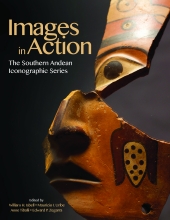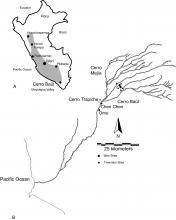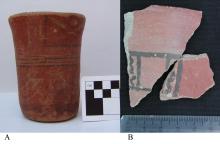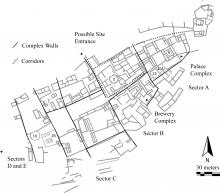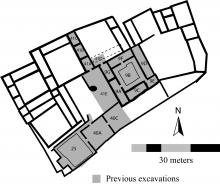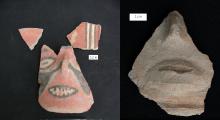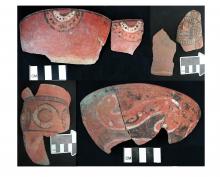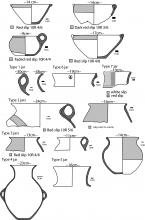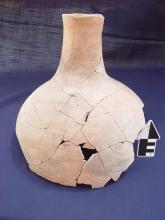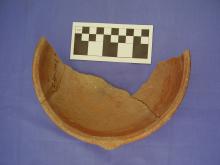Visual database
(a) The Moquegua Valley is located in southern Peru (the area of probable Wari influence is shaded). (b) The Moquegua Drainage is roughly divided into the Middle Valley, which is the area dominated by Tiwanaku settlements, and the steeper upper drainages, which are dominated by Wari-related sites. Nevertheless, each polity had colonial settlements in both areas, and current evidence suggests that for at least some parts of the Middle Horizon, Wari and Tiwanku settlers in the upper drainages shared the use of the same irrigation system (Williams 2001; Williams and Nash 2002).
There is some evidence of exchange of ceramic vessels between Wari and Tiwanku colonists. (a) This Wari cup was found in a burial from the Middle Valley Tiwanaku cemetery at Chen Chen (photo courtesy of Nicola Sherratt). (b) This pottery fragment from the Wari patio group (Unit 9) on the summit of Cerro Baúl. Photo courtesy of Ryan Williams.
The summit of Cerro Baúl is the location of the most monumental Wari site in the Moquegua region. The map shows Sectors A, B, and C (Williams 2001). The architecture at the site includes building forms identified at Huari, Pikillacta, and other Wari centers, such as Wari patio groups and D-shaped structures. Mapping and excavation reveal that the site is organized into several agglutinated complexes. A large compound on the eastern edge of the monumental core of the site has been identified as an elite residence or a provincial palace complex (see Moseley et al. 2005).
An elite residential compound or palace has been identified on the summit of Cerro Baúl in Sector A. The shaded areas were excavated over four field seasons from 2001 to 2007. The current map is an educated guess of wall placement in unexcavated areas. Unit 25 appears to have been an entrance hall, Unit 40A contains activities associated with ceramic production, and Unit 40B is not labeled and is a narrow corridor leading from Unit 25 to 41E. Unit 40C appears to have been a garden space because we found the stumps of three trees, which would never have grown on the summit of Cerro Baúl without human care. This space also lacked a floor of any kind. Units 41A, 41B, and 41C were small rooms built on descending terraces; all were accessed from the adjacent patio (41D), which was partially excavated, and 41E appears to be a very large open space with evidence of ritual activity and productive activities such as lapidary work, the grinding of ceramic tempers and pigments, and weaving.
Examples of small face-neck jars recovered from Cerro Baúl. Both correspond to Type 7 jars in form. Larger face-neck jars have also been found in the brewery and palace, but the eyes are formed with narrow slits. To date, none of the face-neck jars exhibit decorative motifs on the body, but they are limited to the face, headdress, and neck area.
Examples of four decorated cups and bowls recovered from the ritual abandonment smash in Unit 9, a Wari-style patio group on the summit of Cerro Baúl. Museo Contisuyo CB01-4045 (top left), CB01-2563 (top right), CB01-2570 (bottom left), and CB01-4027 (bottom right). Photos courtesy of Ryan Williams.
The plot of Unit 9 from Cerro Baúl shows the results of reconstructing smashed vessels from the patio space. Thus far, over 60 vessels have been identified using an "MNI" approach, but not all 60 have been plotted because of the scattering of fragments of some vessels.
A preliminary typology of ceramic vessels from the patio of Unit 9 on Cerro Baúl. Bowls vary in form, but most have nubs and closely resemble examples from later LIP sites in the region. Type 1 jars are large with short necks and have a rim diameter of 30 cm or more. Type 2 jars are medium in size and have short necks with rim diameters between 15 and 20 cm. Type 3 jars are small in size with short necks and a rim diameter of less than 14 cm. Type 4 jars are large jars that have tall necks that flare at the rim. At present, all examples are slipped red, and the largest example has some decoration. Type 5 jars are similar to Type 4, are smaller, and flare only slightly at the rim. There are few examples of Types 4 and 5 jars so the range for rim diameter has not yet been established. There is only one example of a Type 6 jar. Type 7 jars exhibit a very fine compact paste (see Figure 16.10) and flare less at the rim than Type 5 jars. The example illustrated here is a face-neck jar showing faint eroded orange and white slip alternating in four panels along the rim.
This photo shows an example of a Type 8 jar. It exhibits a very compact paste, which is seen in some face-neck jars and many of the Loro-style bowls found on Cerro Baúl. It has the same rim profile as a Type 7 jar, but the neck is much longer and does not have a face. Photo courtesy of Ryan Williams.
This bowl from the Unit 9 patio ceramic smash exhibits evidence of considerable use before it was included in the ritual deposit. Photo courtesy of Donna Nash.
